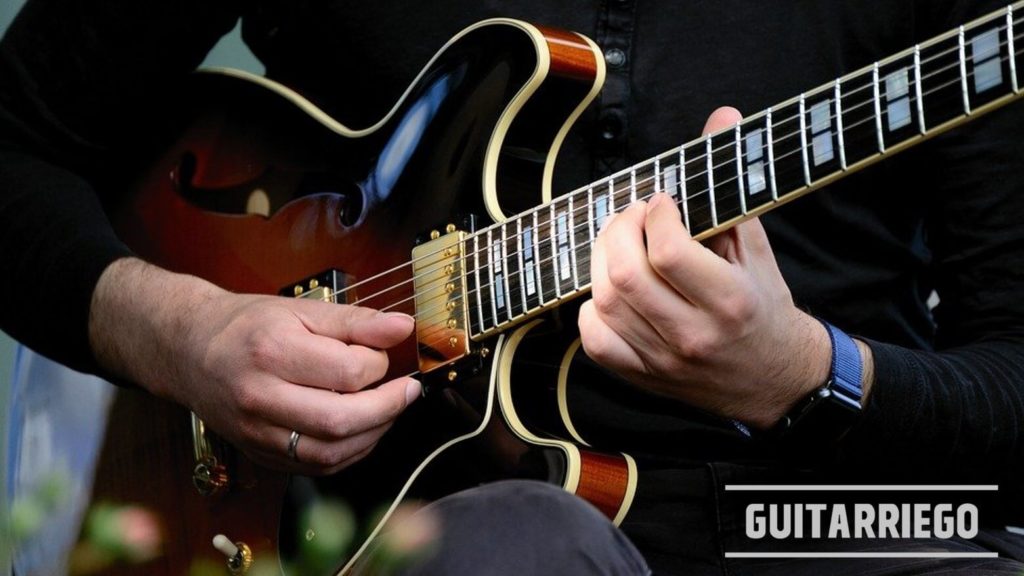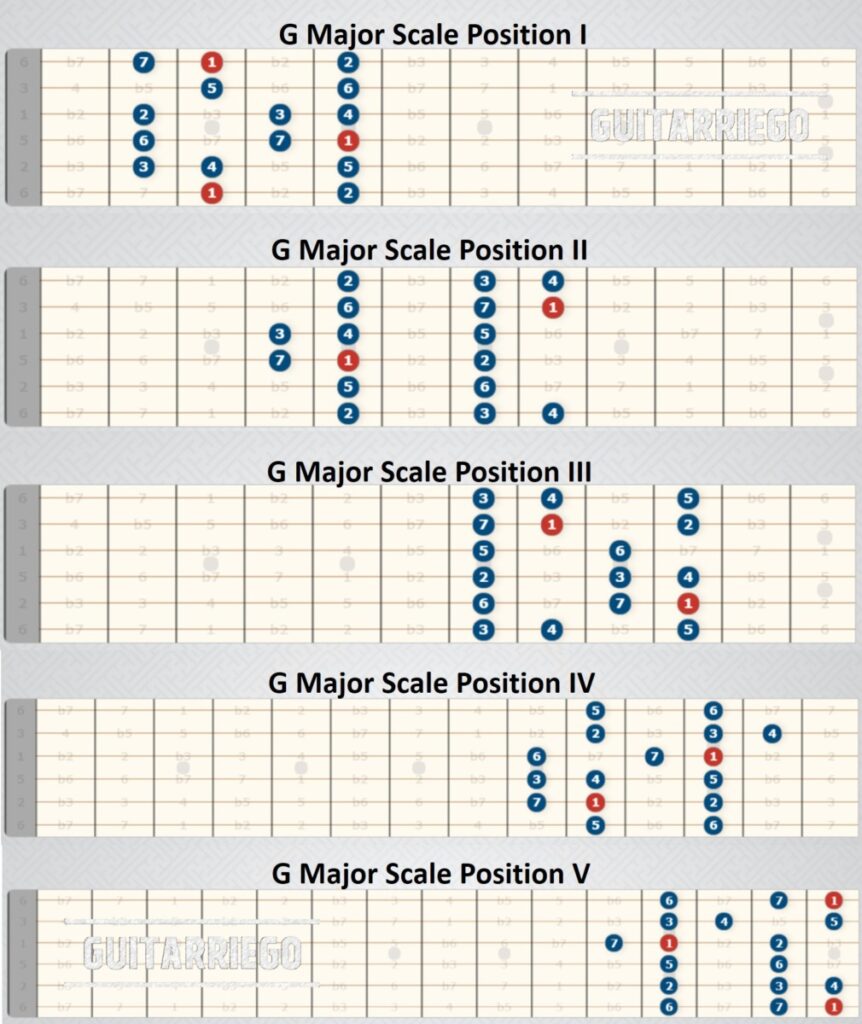Guitar Scales for Beginners – Quick and Easy to Learn

You’ve already learned chords, you already know where the notes are on the fretboard and now, it’s your turn to learn to play the guitar scales. We teach you a quick and easy method to learn, ideal for beginners.
Learn the musical scales for guitar
Learning to play scales on the guitar is a fundamental and important point for those who want to master the instrument, learn to compose, improvise, solo or simply understand what they play. Undoubtedly, the scales are an essential tool for learning and improving the performance of the instrument.
It is not a difficult task, it takes time, patience and study, but it is not something really complex. In fact, once you learn them it comes naturally, like when you learn to ride a bike.
I have heard and read on some sites that they are not fun, but for me, studying scales is something exciting, enriching and motivating. The more you study and learn about scales, the more resources you get, the less monotonous you play, the more you want to play, the faster you learn. In my humble opinion, it is a great virtuous circle of learning. But enough words, let’s get started!
Major Guitar Scales
The scales are a succession of intervals, or a specific distance between the notes that make up the scale. That is, a structure that, if you learn, depending on where you place it on the fretboard, you will be playing the scale of a certain note.
The most common scales on the guitar are:
- Major scale
- Minor scales
- Major pentatonic scale
- Minor pentatonic scale

Before starting with the scales
If you feel that the first steps are somewhat complicated. We recommend that you study them in parts or pieces, dividing it into two or three parts. Once one of the parts is digested, you add the next. When you add the next chunk, you have to make both sound like a single sequence, it shouldn’t sound like two different parts, since everything is the same scale.
Always remember that it is important that when you play a note on the guitar, it does not make strange noises or sound bad. If this is so, repeat it or slow down until all the notes sound right. The one who plays slower, but clearly and without errors, is always a better guitarist than the one who plays fast without being understood and / or with many pifies.
Tones and Semitones
In order to understand the scales, one must understand these two concepts, the Tone and the Semitone, also identified as T or ST / S, they are distances between notes. An ST is the distance between two successive notes, which on the guitar is also two successive frets. Whereas one Tone is exactly the same as two Semitones. Thus ST + ST = T.
So the distance between C and C # is a single note or a ST, while the distance between C and D, is two ST or a T.
With this concept understood, we are now in a position to move forward.
Natural major scale
The major scale is the easiest of all. Since childhood, they teach us the C scale. Did not you know! When they teach us the supposed 7 musical notes: C, D, E, F, G, A, B. Actually, those 7 notes, called natural notes, are simply the 7 notes of the C major scale!
The remaining 5 notes are called harmonic notes or altered notes. A simple way of calling them, which will not be relevant to us in order to learn the scales.
Interpreting the scale structure
It comes easy, right? Let’s complicate it a bit. Let’s interpret the structure of: “C, D, E, F, G, A, B”. If we see, between C and D there are two semi-tones or ST, that is to say, a tone or T, and thus, we continue to see the following notes.

So the structure of the major scale is T-T-S-T-T-T-S. Depending on what note we start with, it will be the scale we have, so if when we start in C, it is the C scale, if we start in G, it is the G scale, and so on.
In summary, all the major scales have the pattern of: T-T-S-T-T-T-S. We will practice the scale by assembling the G scale. The first interval is a T, so from G we go to A, from La we have another T, we go to B, from If we have an ST, we go to C, and so on, until the entire scale is formed:

Already having the G scale, we can practice it on the guitar, let’s review: G A B C D E F# G

Note: Remember that in tablature, the bottom line represents string 6, the thickest, and the top line, string 1, the finest. The number means the fret, so in the example above, you should start by playing on the 6th. string, fret 3, that is, G!
Practice ascending, that is, you start with the lowest note, and work your way up to the highest notes. Then go back down until you return to the G on the sixth string, fret three.
The five positions of the major scale
You already know how to put together the major scale in any key. Now it is your turn to learn the five positions on the guitar fretboard. Memorize and learn the structure of each position. Start by going up and down it.
Usually the most used positions are I and V, but a good guitarist uses all positions. To practice!

Resources for practicing and assimilating positions
Once you have the position memorized, try the following: tap in between: 1-2-3-4 | 2-3-4-5 | 3-4-5-6 | 4-5-6-7 | 5-6-7-8 and so on. You can also do triads, that is, play three notes per beat and do something similar: 1-2-3 | 2-3-4 | 3-4-5 | 4-5-6 | 5-6-7 | 6-7-8 and so on.
Try to improvise on each position, then try from position to position, gradually working your way across the whole fingerboard.

Minor scales for guitar
Natural minor scale
The natural minor scale maintains a similar shape to the major, only that it changes the Tonic, that is, the location of the note that gives the Key or the name of the scale. While the largest was T-T-S-T-T-T-S, where the underlined letter is the Tonic. In the natural minor scale, the tonic would be the sixth note, thus T-T-S-T-T-T-S. If we start the sequence of intervals from the Tonic, then the scale remains: T-S-T-T-S-T-T.
Thus you will see that the structure of the C major scale is the same as the natural A minor scale, since A is the 6th degree, or sixth note of the C major scale.
Continuing with the examples in G, we will practice on the guitar with the natural minor scale of G. The notes played are G – A – Bb – C – D – E – F – G. How to make two full octaves ends up being: G – A – Bb – C – D – Eb – F# – G – A – Bb – C – D – Eb – F# – G.

Note: Remember the flat (b) runs the note one fret down or lower, and the sharp (#) runs the note one fret up or higher. Thus the A of the sixth string, fifth fret, its flat (LAb) is sixth string, fourth fret, and its sharp (A #) is is sixth string, sixth fret.
The five positions of the natural minor scale


Harmonic minor scale
This scale is formed by raising half a tone to the seventh note of the natural minor scale in an ascending manner. We know this scale by the name of the harmonic minor scale because one of the reasons for the alteration of the seventh degree is of a harmonic nature. Altering this note allows the formation of the dominant or 7th chord. of dominant over the V degree of the scale. But we will see that later, when we see how to put together the chords within a scale.
Thus, when running the VII degree or the seventh note of the scale, not only does it approach the previous note, that is, the VI degree, but also, it moves away from its eighth, that is why the T is changed to the S in the VII degree and in the 8th we replace the T by the TM, which means a Tone and a Half-. The following pattern remains: T-S-T-T-S-T-S-TM.
Here you can see the G harmonic minor scale. The notes that are played are G – A – Bb – C – D – Eb – F# – G – A – Bb – C- D – Eb – F# – G.

The five positions of the harmonic minor scale






Melodic minor scale
This scale is another variation of the harmonic minor scale. In addition to altering the VII degree, the VI degree is altered. The main purpose of this alteration is to facilitate the melodic movement from the 6th to the 7th degree, avoiding the 2nd. augmented that is formed on the harmonic minor scale. For this reason it is called melodica.
Thus, the sixth and seventh notes of this scale have one more semitone compared to the harmonic minor scale, but only in an ascending manner. When played downwards, the notes are played in the same way as in the natural minor scale.
The pattern is as follows: T-S-T-T-T-T-S and to descend T-S-T-T-S-T-T.

The five positions of the melodic minor scale






Pentatonic scales
Pentatonic scales are the easiest to learn on the guitar and also the most underrated, although they are very important and fundamental in many musical genres such as Blues, Rock & Roll, among others.
The pentatonic name comes from the fact that it has five notes instead of seven of the natural scales and their variants such as harmonica and melodic.
Pentatonic major scale
All major pentatonic scales are formed by omitting the fourth and seventh notes of the natural major scale. That is, instead of having 1-2-3-4-5-6-7, the pentatonic scale has the following intervals: 1-2-3-5-6.
If we take Do, it would be C – D – E – (F) – G – A – (B). The removed notes being the ones in parentheses, then it remains: C – D – E – G – A.
The structure is T-T-TM-T-TM
Let’s see an example belongs to the G pentatonic major scale.

So the notes that are played are G – A – B – D – E – G – A – B – D – E – G

The five positions of the Pentatonic Major Scale






Pentatonic minor scale
The pentatonic minor scale is the most popular in traditional rock and blues. All minor pentatonic scales are formed by omitting the second and sixth notes of the natural minor scale. Thus, instead of touching 1-2-3-4-5-6-7, you will touch 1-3-4-5-7.
If we take G minor, it would be G – (A) – Bb – C – E – (Eb) – F- G. The removed notes being the ones in parentheses, then it remains: G – Bb- C – D – F – G.
The structure is TM-T-T-TM-T
Let’s see an example belongs to the G minor pentatonic scale.

The five positions of the pentatonic minor scale






Scales across the guitar fretboard
Knowing the structure of the scales, you can play it in the key you want, since the intervals or distance between notes is always the same.
Transpose the scales
Technically transposing a scale, a melody or a group of chords, it consists of bringing all the notes or chords that compose it up or down, maintaining the same interval between the source note and destination note in all notes. This way you will be changing the tonality of what you play.
If you already handle the G major scale, to be able to play the A scale, you simply have to go up two more frets, that is, instead of starting on the sixth string, third fret, that is, starting in G, you start on the sixth string , fifth fret, that is, you start at A, and you play the same structure, you will be playing the A scale. Therefore, what you learn is the scale, then depending on where you touch it, it will be the scale of different tones.
Let’s see an example below. We see how moving the same structure, that of the Minor Pentatonic, it depends on where we place the Tonic, we will be playing in a different tone.
In the first graph, we see that the tonic falls in G, therefore, the minor pentatonic scale is in G or, in other words, it is the G Minor Pentatonic scale.

In the second, we see that the Tonic identified with 1 falls in La, which is why it is the minor pentatonic of La. So successively, we can move through the entire fretboard, transposing the scale to play in the note or key that we want. In the third drawing the scale is in Si and in the fourth in Do.



Knowing and understanding the scales and positions on the guitar
The first step is to memorize the different positions of the scales along the guitar fretboard, the structures, the notes, etc. Once you achieve it, the next step is to understand them, know them, feel what are passing notes, what are notes where you can rest, stressful notes, notes of rest and resolution.
You will learn to know which notes to use according to the chord on which you are playing. It does not sound the same when you play on a G, as when the base is playing a C or a D. Later, we will see the functions of each of the notes in order to understand this more easily.
Guitar Scales Summary
The scales are the fundamental tool to be able to play the guitar, understand what we play, and be able to compose and write your own songs.
Once you learn the scales well, you will have a solid foundation to not only write your songs, but also to understand and learn any song in general.
Remember, it is important to know the scales well, to be able to move throughout the entire fingerboard, expanding your musical, expression and improvisation resources.
For more information, head over to Guitar Quarter.
Related Articles: Blues Scale: Pentatonic Scale, Blue Note and Major Third.
You can share opinions or also chat about this and more with other musicians in our comments section.






